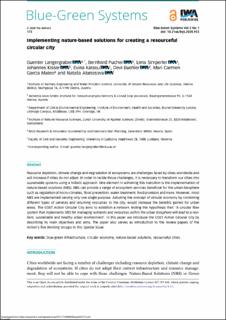Please use this identifier to cite or link to this item:
https://doi.org/10.21256/zhaw-19831| Publication type: | Article in scientific journal |
| Type of review: | Peer review (publication) |
| Title: | Implementing nature-based solutions for creating a resourceful circular city |
| Authors: | Langergraber, Guenter Pucher, Bernhard Simperler, Lena Kisser, Johannes Katsou, Evina Bühler, Devi Mateo, Mari Carmen Garcia Atanasova, Nataša |
| et. al: | No |
| DOI: | 10.2166/bgs.2020.933 10.21256/zhaw-19831 |
| Published in: | Blue-Green Systems |
| Volume(Issue): | 2 |
| Issue: | 1 |
| Page(s): | 173 |
| Pages to: | 185 |
| Issue Date: | 2020 |
| Publisher / Ed. Institution: | IWA Publishing |
| ISSN: | 2617-4782 |
| Language: | English |
| Subjects: | Blue-Green Infrastructure; Circular Economy; Nature-Based Solutions; Resourceful Cities |
| Subject (DDC): | 338.927: Environmental economics and sustainable development |
| Abstract: | Resource depletion, climate change and degradation of ecosystems are challenges faced by cities worldwide and will increase if cities do not adapt. In order to tackle those challenges, it is necessary to transform our cities into sustainable systems using a holistic approach. One element in achieving this transition is the implementation of nature-based solutions (NBS). NBS can provide a range of ecosystem services beneficial for the urban biosphere such as regulation of micro-climates, flood prevention, water treatment, food provision and more. However, most NBS are implemented serving only one single purpose. Adopting the concept of circular economy by combining different types of services and returning resources to the city, would increase the benefits gained for urban areas. The COST Action Circular City aims to establish a network testing the hypothesis that: ‘A circular flow system that implements NBS for managing nutrients and resources within the urban biosphere will lead to a resilient, sustainable and healthy urban environment’. In this paper we introduce the COST Action Circular City by describing its main objectives and aims. The paper also serves as introduction to the review papers of the Action's five Working Groups in this Special Issue. |
| URI: | https://digitalcollection.zhaw.ch/handle/11475/19831 |
| Fulltext version: | Published version |
| License (according to publishing contract): | CC BY 4.0: Attribution 4.0 International |
| Departement: | Life Sciences and Facility Management |
| Organisational Unit: | Institute of Natural Resource Sciences (IUNR) |
| Appears in collections: | Publikationen Life Sciences und Facility Management |
Files in This Item:
| File | Description | Size | Format | |
|---|---|---|---|---|
| 2020_Buehler_Implementing_nature-based_solutions_for_creating_a_resourceful_Blue-Green_Systems.pdf | 482.25 kB | Adobe PDF |  View/Open |
Show full item record
Langergraber, G., Pucher, B., Simperler, L., Kisser, J., Katsou, E., Bühler, D., Mateo, M. C. G., & Atanasova, N. (2020). Implementing nature-based solutions for creating a resourceful circular city. Blue-Green Systems, 2(1), 173–185. https://doi.org/10.2166/bgs.2020.933
Langergraber, G. et al. (2020) ‘Implementing nature-based solutions for creating a resourceful circular city’, Blue-Green Systems, 2(1), pp. 173–185. Available at: https://doi.org/10.2166/bgs.2020.933.
G. Langergraber et al., “Implementing nature-based solutions for creating a resourceful circular city,” Blue-Green Systems, vol. 2, no. 1, pp. 173–185, 2020, doi: 10.2166/bgs.2020.933.
LANGERGRABER, Guenter, Bernhard PUCHER, Lena SIMPERLER, Johannes KISSER, Evina KATSOU, Devi BÜHLER, Mari Carmen Garcia MATEO und Nataša ATANASOVA, 2020. Implementing nature-based solutions for creating a resourceful circular city. Blue-Green Systems. 2020. Bd. 2, Nr. 1, S. 173–185. DOI 10.2166/bgs.2020.933
Langergraber, Guenter, Bernhard Pucher, Lena Simperler, Johannes Kisser, Evina Katsou, Devi Bühler, Mari Carmen Garcia Mateo, and Nataša Atanasova. 2020. “Implementing Nature-Based Solutions for Creating a Resourceful Circular City.” Blue-Green Systems 2 (1): 173–85. https://doi.org/10.2166/bgs.2020.933.
Langergraber, Guenter, et al. “Implementing Nature-Based Solutions for Creating a Resourceful Circular City.” Blue-Green Systems, vol. 2, no. 1, 2020, pp. 173–85, https://doi.org/10.2166/bgs.2020.933.
Items in DSpace are protected by copyright, with all rights reserved, unless otherwise indicated.